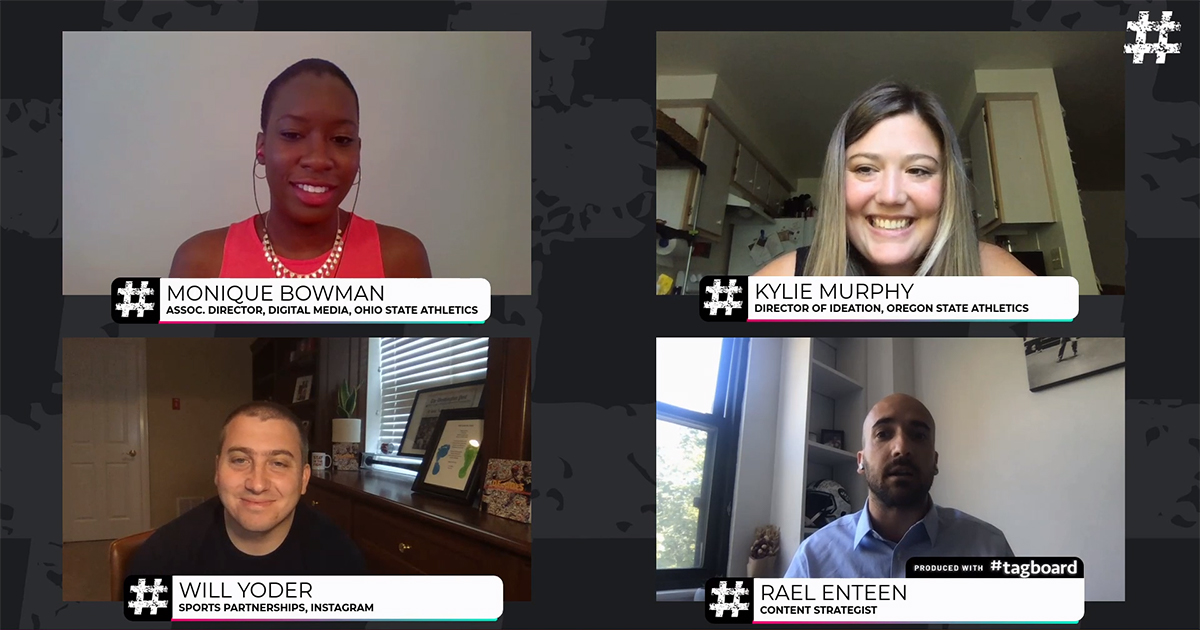How content strategy is changing as the pandemic impacts college athletics
Instagram's Will Yoder Shares How Colleges can Maximize Social Content

By
![]() Team Hashtag
•
3 min read
Team Hashtag
•
3 min read
August 14, 2020
The impact of COVID-19 on the college sports landscape has so far been devastating.
Revenue losses and budget cuts are leaving athletic departments without critical teammates, time, and technology for a level of content creation that fans have come to expect.
So what now?
Hashtag Sports LIVE brought together leaders in the space including Monique Bowman (Associate Director of Digital Media at Ohio State), Kylie Murphy (Director of Ideation at Oregon State), and Will Yoder (Sports Partnerships at Instagram)to break down key trends in college sports content. Content strategist Rael Enteen moderated the panel.
Hashtag Sports LIVE virtual conference sessions are now available for viewing on-demand.
Here are three takeaways from the discussion:
Key Insights:
- Raw, gritty content is more authentic—and often performs better
- Student-athletes need to be part of the content creation and distribution process
- Program branding has major influence on recruiting (especially virtually)
Raw, gritty content is more authentic—and often performs better
Without the ability to have in-person shoots or live events to take video from and the potential for limited staff when events do return, athletic departments have been forced to innovate. For Bowman and Ohio State, they’ve realized the power of the smartphone.
“These phones have great cameras, decent audio, Bowman said. “It’s probably our most powerful tool.”
The period of doing everything virtually has made creators more comfortable with content with slightly lower production value, especially as even the biggest brands in media and sports are living in a world of Zoom interviews and FaceTime clips.
“[Fans] like when their athletes and their coaches and the people they look up to are genuine versus produced,” Bowman said. “I think people are appreciating gritty right now.”
That insight is backed up by the data shared by Instagram’s Will Yoder. “On our platform, we see that far and away that raw phone content does perform the best across the board,” Yoder said.
Student-athletes need to be part of the content creation and distribution process
Getting student-athletes more involved in content creation has been a goal for athletic departments, but not being together on campus makes that even more important. Murphy talked about working on projects that relied on players sending in selfie videos and noted that while she occasionally gets pushback from players, most are willing to help. Part of that, she says, is her department helping the athletes grow their own personal brands as part of the process.
🐰🙌🏽 watch @noahtogiai_04‘s championship play + vote! #BeavsTopPlay2019 https://t.co/acXLTanJsU pic.twitter.com/paQds4slt9
— Oregon State Football (@BeaverFootball) April 3, 2020
“They get a Box link of photos; they know to text us if they want video,” Murphy said. “We have systems in place so we don’t get bogged down with that.”
For Bowman and Ohio State, bringing in the athletes is all about empowerment.
“Our student athletes, we want to showcase them,” Bowman said. “I think having them come even further to the forefront is going to be great.”
In some cases, athletes being involved in the distribution of content is just as important as the creation.
“When a player releases that he was on an [awards] watchlist, they get double the impressions that our football account does,” Murphy said.
Kevin Warner gives us the details on how JMU empowers student-athletes to promote the Dukes' brand on social media.
Read More
Program branding has major influence on recruiting (especially virtually)
The way a college athletics program brands itself on social media does more than just attract fans. It can help sway recruits, too. That has become especially important this spring and summer, with a recruiting dead period meaning no prospective student-athletes could visit campus. Murphy said the central question she asked was “How can we bring campus to our recruits?”
Hashtag Sports sits down with Kyle Seay to break down the ways they brought a stadium renovation to life through donors' computer screens.
Read More
But beyond the world of virtual visits and showcasing facilities, the content a school produces can have a significant impact on how a recruit perceives the school. Perhaps the clearest example of this is LSU, whose creative team capitalized on an incredible season with gripping content that was the talk of the internet nearly every week.
“There is that moment for the really epic, well-produced content… that plays incredibly well on the recruiting angle,” Yoder said. “We’re seeing more and more athletes are looking at the social channels of the schools they are visiting to feel out which brand vibes best with them.”
Learn more about how to effectively engage the modern fan & consumer at Hashtag Sport 2023, an annual conference designed for media and marketing professionals.